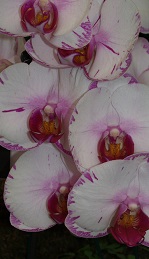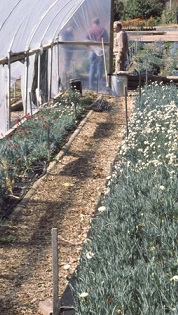Study and grow greenhouse cut flowers!
 Supply markets and increase your cut flower range.
Supply markets and increase your cut flower range.
“Learn how you can extend the growing season by expanding your cut flower range and supplying markets year-round. This is a diverse course for the serious grower.” -- Jacinda Cole B.Sc., Psych. Cert., Cert. Garden Design, MACA, ACS Tutor.
ACS Student Comment:
" I have never found the staff at any other learning institution as supportive as the staff at ACS. This gives one a lot of peace of mind and confidence to go on - at every squeak from my side, you guys have always been there, immediately to sort me out. The feedback on my lessons has always been really good and meaningful and an important source of my learning. Thanks!..." -- anonymous.
In most countries it is now possible to get the most popular types of cut flowers almost any time of the year. Industry has made this possible by doing three different things:
1. Expanding trade between countries (e.g. Australian tulips might be flown to the Netherlands in August and September, when they are not flowering in The Netherlands; and Dutch tulips might be flown to Australia when it is autumn in Australia)
2. Breeding new varieties has extended the flowering season for some plants. It is now, for instance, possible to grow Chrysanthemum varieties that flower all year round in some climates.
3. Growing in greenhouses has enabled farmers to take control of conditions that stimulate flowering; and cause plants to not only grow faster, but also flower at times when they might not have otherwise flowered.
Course Content
There are twelve lessons in this course, as outlined below:-
1. Introduction to Cut Flower Production
Explore the nature and scope of Cut Flower production in greenhouses.
2. Cultural Practices
Learn to determine key cultural practices that are commonly required to develop and maintain a good rate of growth in a cut flower crop.
3. Flower Initiation & Development
Learn to explain the initiation and development of flowering in a cut flower crop.
4. Pest & Disease Control
Determine management practices for cut flower crops grown in a greenhouse
5. Greenhouse Management A.
Discuss a range of greenhouse management techniques related to cut flower production.
6. Greenhouse Management B.
Explain a range of greenhouse management techniques related to cut flower production.
7. Management, Harvest & Post Harvest
Determine a range of harvest and post harvest techniques related to cut flower production.
8. Herbaceous Perennials
Determine greenhouse production techniques for selected herbaceous perennials.
9. Annuals & Biennials
Learn about greenhouse production techniques for selected annuals and biennials.
10. Bulbs, Corms, Tubers & Rhizomes
Learn how selected bulbs, corms, rhizomes or tubers are grown in greenhouses.
11. Filler Plants
Determine greenhouse production techniques for selected filler plants.
12. Miscellaneous
Determine greenhouse production techniques for roses, and for orchids.
AIMS
- Describe the nature and scope of cut flower production in greenhouses.
- Determine key cultural practices that are commonly required to develop and maintain a good rate of growth in a cut flower crop.
- To explain the initiation and development of flowering in a cut flower crop.
- To determine management practices for cut flower crops grown in a greenhouse.
- To discuss a range of greenhouse management techniques related to cut flower production.
- To explain a range of greenhouse management techniques related to cut flower production.
- Determine a range of harvest and post harvest techniques related to cut flower production.
- Determine greenhouse production techniques for selected herbaceous perennials.
- Determine greenhouse production techniques for selected annuals and biennials.
- Determine greenhouse production techniques for selected bulbs, corms, rhizomes or tubers.
- Determine greenhouse production techniques for selected filler plants.
- Determine greenhouse production techniques for roses and orchids.
The Importance of Light
 One major thing you need to remember for achieving the best, with most flowering plants is - to get a lot of flowers, you need sunlight for at least 6 hours a day. Intensity as well as duration can be important; and for some types of plants, the sequence of change in light over several months, may cause flower buds to form.
One major thing you need to remember for achieving the best, with most flowering plants is - to get a lot of flowers, you need sunlight for at least 6 hours a day. Intensity as well as duration can be important; and for some types of plants, the sequence of change in light over several months, may cause flower buds to form.
Some flower growers are able to produce flowers all year round by using curtains to create periods of dark, and artificial lights to create light conditions, in a greenhouse.
Light also causes plants to release scents, both from foliage and flowers.
Plants such as roses also need reasonably long periods of sunlight to flower well. Some, however, will flowers with less light – flower carpet roses are a good example. These will still flower with just 4 or 5 hours of sunlight a day, so if you want to bring a potted one indoors you can provided you place it in a well-lit area.
Optimise Plant Health and Prolong Flowering
Every species has different requirements for optimal growth; but the following hints do apply to most types of cut flowers that we grow.
- Provide the right light conditions for the plant - both inside and outdoors.
- Dead head regularly by snipping off spent flowers – this encourages the plant to produce more flowers.
- Fertilise regularly but take care to not overdo nitrogen as this will produce lots of leaves at the expense of flowers. Seaweed extract is a great tonic for potted plants because it contains growth hormones as well as nutrients; and is very difficult to overdo. When mixed with fish emulsion it makes a perfect all-round fertiliser.
- Water your plants regularly but if they are potted don’t saturate the mix – keep it slightly moist but not wet.
- Consider producing potted plants such as a ‘potted colour’ range – they last longer than a bunch of flowers
- Check for pests or diseases and act early!
Why Study with ACS?
Design your own learning pathway.
Study at your own pace, from anywhere, at any time.
Receive prompt, expert support from our team of committed and friendly tutors.
Your learning is our priority. We are flexible and adaptable to meet your educational needs!
Enrolling is easy - just go to the top of this page and select your study method and payment option.
If you have any questions about studying with ACS, or want to know more about any of our courses, get in touch with our specialist tutors today.
They will be happy to answer your questions and look at different study options to fit in with your goals.